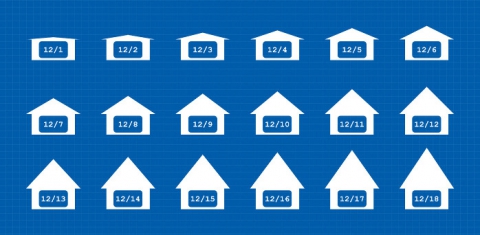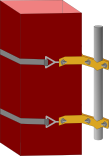Rooftop Mounting Guide
Getting Started
Most of the time, the best place to put a wireless router will be on the roof of your house or organization’s building. Every roof is unique, so this guide can’t cover every possibility! We are just covering your options here, it will be up to your best judgement to decide which method to use.
First and foremost - when working on any roof, be very careful. Any slip or slide could lead to a long fall, and serious injury or death.
If you aren't comfortable working on the roof, don't do it.
Get some help! Ask around your community and see if there are any professional roofers, cable TV or phone installers, or other folks that have experience working in places like this. There are two basic kinds of roof: flat and pitched. Flat roofs are often the easiest to work on, and the safest. Pitched roofs are slanted, and in some cases are very steeply slanted. We advise to only work on a roof with a shallow roof pitch. In the picture below, the roofs in the top row are safest, while the bottom two rows of roofs are likely to be tricky and dangerous.

With either roof type, there are a variety of roof coverings and sealants to be aware of. These all protect the roof and make it waterproof. The most important rule when installing something on a roof: never drill any holes in the roof surface itself. Even if the holes are sealed properly, they will eventually leak, and lead to problems in the long run.
Chimney Attachments
When there is a tall chimney on the roof, we can mount a pole, mast or pipe to the roof using one of two methods: drilling anchors to hold a pipe in to the chimney, or using a strap mount. It is up to you if you want to drill holes in your chimney. NOTE: If your chimney is missing bricks, mortar, or does not look to be in good shape, please do not mount anything to it! These will generally work on either flat or pitched roofs.
Anchor Mount
 The typical anchor mount is made up of two v-shaped pieces of metal, which you attach to the chimney with screws and anchors. Kits are sometimes available at Radio Shack, or online:
The typical anchor mount is made up of two v-shaped pieces of metal, which you attach to the chimney with screws and anchors. Kits are sometimes available at Radio Shack, or online:
- http://bit.ly/vbkbOD
- http://www.starkelectronic.com/cmwalmt.htm
A piece of electrical conduit, pipe or antenna mast can be used, as these kits don’t include one. The local hardware store should be able to help with this. You will only need about 4 to 5 feet of mast, but make sure it is painted or galvanized so it does not rust! Holes must be drilled in to the chimney with this method, and plastic or lead sleeve anchors must be placed in the holes. Sets of these are usually available from the hardware store. You can then screw in the mounting brackets, and the anchors will hold it in to the brick. Use two brackets, as just one isn’t strong enough. Attach the pipe or mast to the brackets, and hang the wireless router to the pipe.
Strap Mount
 A strap mount uses steel straps wrapped around the chimney, which are tightened with a wrench to secure brackets for a pole. Usually these must be ordered on-line:
A strap mount uses steel straps wrapped around the chimney, which are tightened with a wrench to secure brackets for a pole. Usually these must be ordered on-line:
- http://www.starkelectronic.com/cmwalmt.htm
- http://bit.ly/rCSIpf A piece of electrical conduit, pipe or mast can be used, as these kits don’t include one.
The local hardware store should be able to help with this. Strap mounts require no holes to be drilled in to the chimney, so it may be the best option on older chimneys where the brick is softer. Use two strap and bracket sets, as one isn't strong enough to hold the mast. Once the straps are wrapped around the chimney and tightened, the mast can be attached to the bracket, and the wireless router can be attached to the mast.
Vent Attachments
 When there is a sturdy vent stack pipe coming out of the roof, we can mount a mast to it to extend the height. There are various kinds of mounts, but they are all essentially made up of two pieces of metal which bolt around the vent stack and your mast, and attach them firmly together. You may have luck at your local hardware store or Radio Shack finding one, but they are generally available on-line:
When there is a sturdy vent stack pipe coming out of the roof, we can mount a mast to it to extend the height. There are various kinds of mounts, but they are all essentially made up of two pieces of metal which bolt around the vent stack and your mast, and attach them firmly together. You may have luck at your local hardware store or Radio Shack finding one, but they are generally available on-line:
- http://bit.ly/rVtlVN
- http://www.starkelectronic.com/cmwalmt.htm
A piece of electrical conduit, pipe or antenna mast can be used, as these kits don’t include one. The local hardware store should be able to help with this. You will only need about 4 feet of mast, but make sure it is painted or galvanized so it does not rust! It is important to note that you should only mount to a metal vent stack. A plastic or PVC vent is too weak to hold a mast - over time the wind will shake the mast and cause the plastic vent to crack. The vent also needs to protrude at least a foot out of the roof if you are using a mast 4 feet or more in length. This allows for the two vent stack mounts to be spaced 10” to 12” apart. If your mast is only a foot or two long, you might be able to get away with a single mount.
Eaves Attachments
 These are placed at the end of a pitched roof, where other methods won't work. It won’t work on a flat roof, as there usually isn't an eave! It must be drilled in to the wood supports of the roof. There are various kits with different lengths of bottom supports, but look for adjustable models which can stretch out to best fit your roof:
These are placed at the end of a pitched roof, where other methods won't work. It won’t work on a flat roof, as there usually isn't an eave! It must be drilled in to the wood supports of the roof. There are various kits with different lengths of bottom supports, but look for adjustable models which can stretch out to best fit your roof:
- http://bit.ly/sa3im3
- http://www.starkelectronic.com/cmhard.htm (Search for 9030 or Eave mount)
As in all of these installations, a galvanized or painted antenna mast is required. Since you are mounting this to the trim boards along the edge of your roof, make sure they are in good shape. Rotten wood won't hold up well and the mount may fall out or further damage your roof in high winds. There should be about one foot between the top attachment and the bottom support in order to properly support an antenna mast. This method isn’t recommended for very long masts, up to 4 or 5 feet should be fine.
Non-Penetrating Attachments
 This type of mounting method uses weight to secure a mast to the roof - there is no drilling or bolting required. These are generally the preferred method if you don't have a chimney or vent to mount to, but they can be used even if you do have those available. They are available from lots of sources now that satellite TV is so popular, but a few good sources:
This type of mounting method uses weight to secure a mast to the roof - there is no drilling or bolting required. These are generally the preferred method if you don't have a chimney or vent to mount to, but they can be used even if you do have those available. They are available from lots of sources now that satellite TV is so popular, but a few good sources:
- http://www.aisatellite.com/products.htm
- http://bit.ly/pQGj2Z These types are only to be used for flat roofs.
There are also non-penetrating mounts for pitched roofs - they mount at the peak of the roof and have a flap that fits on each side of the roof:
- http://bit.ly/rT0vlr
Whichever non-penetrating hardware is used, you must do the following:
- Use a rubber mat underneath the mount. This is to protect the roof from damage.
- Use concrete blocks or some other weight to hold it in place. It might seem sturdy without them, but wind is a powerful thing.
You really don't want one of these falling off of your roof.
Conclusion
As a home owner or building owner, use whichever method above you are most comfortable with. It’s your house! Read through your options above and see what works best for you. If you are still not sure, ask around your neighborhood. See what your neighbors use to mount their satellite dishes, TV antennas, or wireless equipment. Ask around, maybe they can help you install it as well! Also keep in mind there might already be something on your roof that you could use to mount a wireless router to. Generally a pipe or antenna mast should be around 1½” in diameter to best fit the equipment. If you can get to the existing mount safely, by all means use it. One last note: be safe!